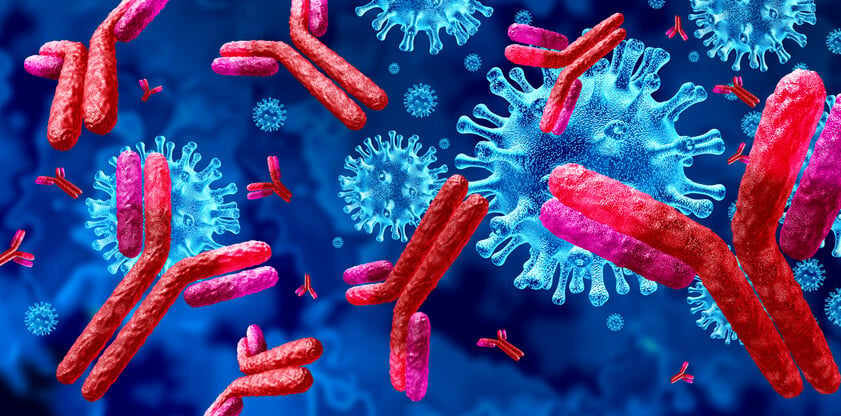Overview of antibodies
Antibodies are part of the adaptive immune response of the body. After an initial defense against a pathogen from immune cells such as neutrophils, our body launches B and T cells to create antibodies to fight a pathogen. The structure of an antibody looks like the letter Y of the latin alphabet. The central part, which goes from the stalk up to the arms of the antibody, is called the “heavy chain”. A “light chain” is attached to the upper arms of the heavy chain. The stalk is also called the “Fc” region and the arms on top are called the “Fab” region. The Fab region contains the part of the antibody that binds pathogens. This region that binds pathogens is called the paratope, and it binds an epitope on a pathogen. This interaction is specific and is based on the tertiary structure and amino acid sequence. There is one epitope per paratope.
Monoclonal antibodies vs polyclonal antibodies
In any patient blood sample, there will be a polyclonal mixture of antibodies. This means that there will be antibodies present that bind many types of epitopes. To repeat, each paratope will bind only one epitope, but there will be a great diversity of epitopes from all the pathogens your immune system has fought. Monoclonal antibodies is when all the antibodies in a solution target the same epitope. This is very advantageous for situations that require the precision of one epitope. In brief, polyclonal antibodies are a heterogeneous epitope mixture while monoclonal antibodies are a homogeneous solution. Monoclonal antibodies are used in research and as therapeutics. You can read more about producing monoclonal or polyclonal antibodies in our article "custom antibody production".
Advantages of Monoclonal antibodies in research
Monoclonal antibodies are widely used in gold standard techniques such as ELISA, western blotting, flow cytometry and other affinity based assays or isolation techniques. For ELISA, a monoclonal antibody helps detect a specific antigen of interest. Monoclonal antibodies can also help detect specific cells in flow cytometry. Monoclonal antibodies are also useful for protein purification. The monoclonal antibody can be used to bind a protein which can then be isolated from it’s solution.
Advantage of Monoclonal antibodies in therapeutics
Due to their homogeneity monoclonal antibodies are made for specific tasks in fighting disease. The monoclonal antibodies can be made to target a certain cell to suppress or induce certain biological processes. For example, monoclonal antibodies are used for cancer treatment. Anti-PD1 monoclonal antibodies target a surface protein called PD-1 (programmed death) on immune cells. Cancer cells bind PD-1 to evade the immune response, but when antibodies bind PD-1 the cancer cells are vulnerable to destruction.
Magnetic beads and the advantage of monoclonal antibodies
Magnetic beads can be used as part of the procedure for creating monoclonal antibodies. Monoclonal antibodies are more difficult to produce than polyclonal antibodies. All harvested antibodies must be produced from a single immune cell. Magnetic beads can be used to isolate the antibodies to harvest them. You can read more about this procedure in our article "Antibody capture".
Related news
- Aspects of available Chemiluminescent immunoassay (CLIA) kits in the market
- Streptavidin HRP
- Preliminary considerations for CLIA design





